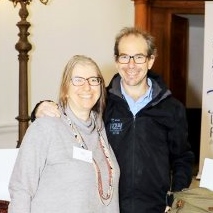News
Children’s literature contains essential life lessons
It’s essential to read to children or tell them stories from birth, said clinical psychologist Judith Ancer at a session titled, “Using literature to help children grow and heal” at the Jewish Literary Festival in Cape Town, co-presented with her brother, author and journalist, Jonathan Ancer.

MOIRA SCHNEIDER
“To infants, even before cognition, it’s about connection, attachment, belonging, safety, and security,” she said, mentioning a programme at Tygerberg Hospital’s neonatal intensive care unit that encouraged moms, who often felt powerless, to read to their children, making reading the emotionally connecting experience it should be.
“Books need to be not precious in a way that children can’t engage with them,” Judith said. Being read to from a young age enables children to learn about language, rhythm and rhyme, and different sounds.
They also learn that books are a source of knowledge, not just Google.
Children’s literature can be oral, she said. “I encourage parents to tell their stories, about their cultures, their lives, their values – they share what is to be expected, and what isn’t.”
Fairy stories are often frightening but important because they tell a truth to kids that the world is not so fair. “It’s a warning – telling you to be careful, to use your wits. They’re important life lessons, helping kids in symbolic form to face what is difficult,” Judith said.
Using the example of the story of Hansel and Gretel, Judith noted that in most of the fairy stories, the majority of “active, engaged” heroes were girls.
The fairy godmother and wicked stepmother are different versions of the same person, according to psychoanalyst Melanie Klein, and give children a way to process a loving, nurturing mother who sometimes behaves differently.
“Although the stories are unreal, they’re not untrue. Bad things do happen, and we have to face them. If we whitewash the stories, we do them a disservice,” she said.
Picture books allow children to identify and process feelings, Judith said. “The best books allow children to deal with their unacceptable parts – such as greediness or messiness – and process them.”
In Maurice Sendak’s Where the Wild Things Are, for example, when Max is facing wild things, he is facing parts of himself. “All children have wild, dark, and tumultuous feelings,” she said.
Books stimulate creativity, and help children to understand different perspectives. The Velveteen Rabbit, for example helps them understand that they are fundamentally worthy.
Subversive books, such as those by Roald Dahl or Judy Blume, challenge convention. “Some help kids to have a frame of reference, and give them the courage to think differently,” Judith said.